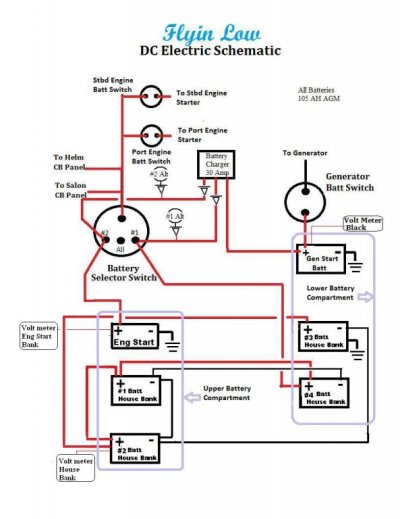timjet
Guru
- Joined
- Apr 9, 2009
- Messages
- 1,920
Based on your comments on previous threads I've decided to upgrade by battery system. I currently have 5 AGM batteries, one for generator start, two connected in parallel and connected to the #1 position of the Battery selector switch and two more connected in paralled and connected to the #2 battery selector switch.
I'm changing this so that the 4 batteries connected to the 1 and 2 positon of the battery switch are now all connected in parallel and connected to the #1 positon of the battery switch. I'm adding a wet cell engine start battery and connecting this to the #2 position of the battery selector switch.
This gives me 420 amps for the house which I need due to my energy hungry fridge.
Attached are the schematic diagrams, the first is the current state and the second is my revised state.
One question; Notice that in the revised state schematic the Engine start battery negative terminal is connected to the negative terminal of a battery in the house bank. I did this because it is much easier than running a separate negative cable to ground. Anything wrong with this??
Any suggestions please post.
Thanks
Note: Pressing ctrl + will enlarge the images
-- Edited by timjet on Sunday 25th of March 2012 03:54:17 PM
I'm changing this so that the 4 batteries connected to the 1 and 2 positon of the battery switch are now all connected in parallel and connected to the #1 positon of the battery switch. I'm adding a wet cell engine start battery and connecting this to the #2 position of the battery selector switch.
This gives me 420 amps for the house which I need due to my energy hungry fridge.
Attached are the schematic diagrams, the first is the current state and the second is my revised state.
One question; Notice that in the revised state schematic the Engine start battery negative terminal is connected to the negative terminal of a battery in the house bank. I did this because it is much easier than running a separate negative cable to ground. Anything wrong with this??
Any suggestions please post.
Thanks
Note: Pressing ctrl + will enlarge the images
-- Edited by timjet on Sunday 25th of March 2012 03:54:17 PM



